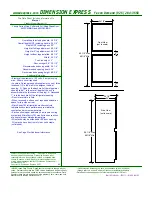
7
3. Using a flat head screwdriver, pry off the bottom hinge cover (12). Using a Phillips head screwdriver, loosen
and remove screws (3c) and (13) and bottom hinge (10).
4. Move bottom hinge (10) to the opposite side and re-insert all screws (3c) and (8). Bottom hinge cover (12)
should clip back onto the bottom hinge (10).
5. Place the washer (11) over the hinge support rod (9) and place the door back on the bottom hinge by aligning the
hinge support rod (9) with the outer hinge hole on bottom hinge (10).
6. Re-attach top hinge (4) using screws (3a). Insert lock cap (6), screws (7) and (8), and clip on hinge cap (2).
Stainless steel doors include a handle centered in the middle of the door. There is no need to alter the location of the
handle.
Glass doors include integrated door pull handles. There is no need to alter the location of door pull handles.
OPERATING YOUR WINE CELLAR
Each wine cellar includes an operating panel on the front of the unit. This operating panel includes several features to
operate and control the temperature of both the UPPER and LOWER zones of the wine cellar. The operating panel
includes the following features:
Power
:
Turns the wine cellar system on or off.
Lighting:
Turns the interior wine cellar light on or off.
Power/Lighting:
Lock/Unlock button.
°
C/
°
F:
Alters the temperature display to Fahrenheit or Celsius
Upper Zone Display Window:
Displays temperature of upper zone.
Bottom Zone Display Window:
Displays temperature of lower zone.
Temp.
Up
Increases temperature by 1
°
.
Temp.
Down
Decreases temperature by 1
°
.
Zone Select:
Switches temperature control between upper and lower zone.
BEFORE YOU START:
The wine cellar should be placed in a location where the ambient temperature is between
60-80
°
Fahrenheit. If the ambient temperature is outside this range, the performance of the unit may be affected. For
example, placing your unit in extreme cold or hot conditions may cause interior temperatures to fluctuate.




























